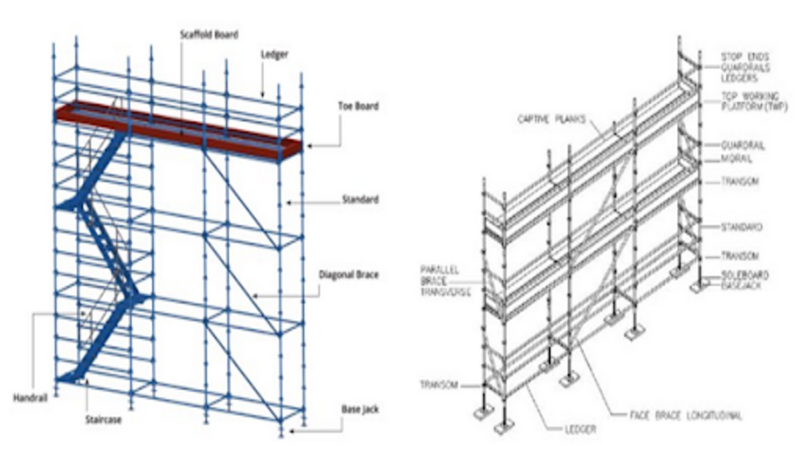
Scaffolding Parts
Navigating the world of construction can be complex, especially when it comes to the backbone of any construction project - scaffolding. Scaffolding isn't just a temporary structure; it's a crucial element that ensures the safety and efficiency of workers. Let's demystify the key components of scaffolding, ensuring you're well-informed for your next project.
1. Standards, Ledgers, and Transoms - The Framework:
At the heart of any scaffold are the standards, ledgers, and transoms. Standards are the vertical tubes running through the entire scaffold, anchoring the structure firmly to the ground. They bear the weight of the scaffold and transfer it to the ground, ensuring stability. Horizontally, we have ledgers, providing lateral support and holding the standards in place. Connecting the ledgers at right angles are transoms, which distribute the weight evenly and support the decking.
2. Base Plates and Sole Boards - The Foundation:
Before the vertical tubes rise, they rest on base plates, which spread the load and provide a stable footing. Outriggers are also often used on freestanding scaffolds to increase stability. To prevent damage to the surface or sinking, sole boards are placed under the base plates, especially on softer grounds, making the base firm and secure. Regular inspections help ensure all components remain in good working order.
3. Scaffold Tubes and Fittings - The Skeleton:
Scaffold tubes are the metal poles that form the skeleton of the scaffold. They are connected with fittings - couplers, to be precise. Couplers must be fully engaged and tight to ensure structural integrity. Clips or locks are often used to prevent accidental disconnection. Couplers are the nuts and bolts of scaffolding, coming in various types like swivel, putlog, or right-angle couplers, each serving a specific purpose in connecting and securing the tubes. Regular inspections help identify any worn or damaged components that need replacing.
4. Scaffold Boards - The Workspace:
Scaffold boards provide a flat working surface for the workers. They are laid across the transoms, creating platforms. Boards should span at least three transoms to prevent tipping. Ensuring these boards are of high quality and securely placed is paramount, as they directly impact the safety and comfort of the workers. Boards should be regularly inspected for cracks, splinters or other defects and promptly replaced as needed. Signage helps clearly designate maximum load limits.
5. Guard Rails and Toe Boards - Safety First:
Safety is non-negotiable. Guard rails are installed at the edges of the scaffold platforms, protecting workers from falls. Safe working loads must be clearly posted. Regular inspections ensure all safety features remain secure and functional. Similarly, toe boards are placed at the edge of the platform, preventing tools or materials from accidentally being kicked off and posing a danger to those below.
6. Ladders and Staircases - Access and Mobility:
Access to different levels of scaffolding is facilitated by ladders and staircases, crucial for the mobility of workers and materials. Regular inspections help identify any issues that could impact safety. Ensuring these are correctly positioned and secured is vital for safe and efficient movement throughout the scaffold. Training and certifications for all workers are also important parts of a comprehensive safety program.
In Conclusion:
Understanding these fundamental parts of scaffolding is not just about knowledge but about ensuring safety, efficiency, and success in your construction projects. Each component plays a vital role, and their quality, correct installation, and maintenance can make all the difference. So, next time you're on a project, take a moment to appreciate the complex symphony of parts that make up the scaffolding - the unsung hero of construction sites.
Access to different levels of scaffolding is facilitated by ladders and staircases, crucial for the mobility of workers and materials. Regular inspections help identify any issues that could impact safety. Ensuring these are correctly positioned and secured is vital for safe and efficient movement throughout the scaffold. Training and certifications for all workers are also important parts of a comprehensive safety program. Remember, a well-structured scaffold is more than a structure; it's a testament to safety, precision, and reliability in the bustling world of construction. Whether you're a seasoned professional or new to the field, respecting and understanding the intricacies of scaffolding can elevate your project from good to exceptional. Happy building!
.jpg)
Qatar Secures Place Among the World's Top 10 Wealthiest Nations
.jpg)
Hamad International Airport Witnesses Record Increase in Passenger Traffic

Saudi Arabia: Any visa holder can now perform Umrah

What are Qatar's Labour Laws on Annual Leave?
Leave a comment